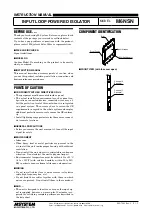
currents
I
1
and
I
2
denote the fundamental frequency components on the phase and
neutral sides of the current. The amplitude of the differential current I
d
is obtained using
the equation (assuming that the positive direction of the current is towards the machine):
I
I
I
d
=
+
1
2
GUID-9BC6A743-CA43-407E-8340-7463F15C8128 V1 EN
(Equation 105)
During normal conditions, there is no fault in the area protected by the function block, so
the currents
I
1
and
I
2
are equal and the differential current I
d
= 0. However, in practice
some differential current exists due to inaccuracies in the current transformer on the phase
and neutral sides, but it is very small during normal conditions.
The module calculates the differential current for all three phases.
The low-stage differential protection is stabilized with a bias current. The bias current is
also known as the stabilizing current. Stabilization means that the differential current
required for tripping increases according to the bias current and the operation
characteristics. When an internal fault occurs, the currents on both sides of the protected
object are flowing into it. This causes the biasing current to be considerably smaller, which
makes the operation more sensitive during internal faults.
The traditional way for calculating the stabilized current is:
I
I
I
b
=
−
1
2
2
GUID-34FA472E-E419-4A0E-94A3-238D7A3CE5ED V1 EN
(Equation 106)
The module calculates the bias current for all three phases.
Through-fault detection
Through-fault (TF) detection module is for detecting whether the fault is external, that is,
going through, or internal. This information is essential for ensuring the correct operation
of the protection in case of the CT saturation.
•
In a through-fault situation, CTs can saturate because of a high fault current
magnitude. Such AC saturation does not happen immediately when the fault begins.
Thus, the TF module sees the fault as external because the bias current is high but the
differential current remains low. If the AC saturation then occurs, a CT saturation-
based blocking is allowed to work to prevent tripping.
•
Normally, the phase angle between the machine neutral and line side CTs is 180
degrees. If an internal fault occurs during a through fault, an angle less than 50
degrees clearly indicates an internal fault and the TF module overrules, that is,
deblocks the presence of any blocking due to CT saturation.
Section 4
1MAC059074-MB A
Protection functions
570
615 series ANSI
Technical Manual
Summary of Contents for Relion 615 series
Page 1: ... RELION PROTECTION AND CONTROL 615 series ANSI Technical Manual ...
Page 2: ......
Page 39: ...Section 17 Glossary 1181 Table of contents 615 series ANSI 33 Technical Manual ...
Page 40: ...34 ...
Page 64: ...58 ...
Page 216: ...210 ...
Page 884: ...878 ...
Page 1038: ...1032 ...
Page 1136: ...1130 ...
Page 1172: ...1166 ...
Page 1180: ...1174 ...
Page 1186: ...1180 ...
Page 1192: ...1186 ...
Page 1193: ...1187 ...
Page 1194: ......
Page 1195: ......
















































